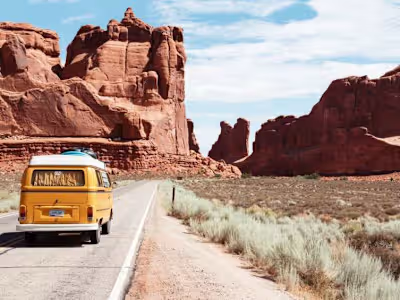SEO Article/ Blog Post
Work order: TC000973 Primary Keyword: List of national parks by size Additional keywords: Smallest national park in the U.S., largest U.S. national park, size comparison of national parks, area of national parks in the United States, geographic size of national parks, land area of national parks, size rankings of national parks, dimensions of U.S. national parks, extent of national park lands, spatial distribution of national parks, comparative sizes of U.S. parks, physical expanse of national parks. Meta Description: List of U.S. National Parks by Size From this table, you can find the U.S.'s most significant and minor national parks. List of the U.S. National Parks by Size Have you ever wondered which U.S. national park extends the most significant area or which is the densest yet evenly mesmerizing? Understanding the size of U.S. national parks offers profound insights into the variety of lands and ecosystems preserved across the country. These parks range from extensive wilderness areas where you can lose yourself in the environment's magnificence to smaller parks that propose intimate meets with distinctive natural features. This comprehensive guide discovers some of the largest and smallest national parks in the United States, emphasizing their unique landscapes, ecological importance, and recreational chances. Whether planning your next journey or just curious about the natural miracles conserved within these parks, this list of national parks by size will enlighten and motivate you. Key takeaways: U.S. national parks differ significantly in size from the vast expanses of Denali and Wrangell-St. Elias to the intimate settings of Hot Springs and American Samoa, all offering exceptional natural wonders and entertaining opportunities. Largest National Parks: 1. Denali National Park and Preserve: Denali National Park and Preserve, situated in the heart of Alaska, is one of the most famous national parks in the United States. This park, covering over 6 million acres, is an enormous wilderness that offers a truly remote and breathtaking experience. The park is named after Denali, North America's tallest mountain, which rises impressively to 20,310 feet. This colossal mountain overlooks the landscape and is a main draw for mountaineers and adventurers worldwide. Denali's size permits various ecosystems, from lowland taiga forests to tall alpine tundra. Wildlife is plentiful, with chances to see grizzly bears, wolves, bison, caribou, and moose in their natural environments. The park's six million acres remain undeveloped, allowing tourists to discover its original wilderness through trekking, backcountry camping, and wildlife viewing. The Denali Park Road, a 92-mile route into the park, gives access to some of its most fabulous sites and is the only road inside this expansive zone. Planning a family trip? Check out our recommendations for the best U.S. national parks that cater to kids of all ages. 2. Wrangell-St. Elias National Park and Preserve: Wrangell-St. Elias National Park and Reserve is the largest national park in the United States, covering about 13.2 million acres. Located in Alaska, it is a site of superlatives and extremes. It contains nine of the 16 highest mountains in the United States, including Mount St. Elias, which rises to 18,008 feet. The park's colossal size includes an extensive range of lands, from glaciers and icefields to rough mountains and lavish valleys. One of Wrangell-St. Elias's exclusive feature is its widespread glacial system, with some of the largest glaciers in North America discovered here. The Malaspina Glacier, for example, is larger than the state of Rhode Island. The park's size and remoteness offer unparalleled adventure opportunities, including mountaineering, trekking, and discovering historic mining towns. The park remains undeveloped despite its size, delivering a sense of solitude and an authentic wilderness experience. 3. Gates of the Arctic National Park and Preserve: Gates of the Arctic National Park and Preserve, covering around 8.4 million acres in northern Alaska, is prominent for its untouched Arctic wilderness. It is one of the most isolated and least visited national parks in the United States, primarily due to its absence of roads and organization. The park is situated entirely north of the Arctic Circle, proposing a distinctive and challenging atmosphere for those looking for a true wilderness journey. The park's name originated from the two prominent peaks, Frigid Crags and Boreal Mountain, which form a natural doorway to the Arctic. This extensive area contains part of the Brooks Range, a peak range that bounces through northern Alaska. Gates of the Arctic is a refuge for wildlife, including caribou, grizzly bears, wolves, and Dall sheep. Its undamaged landscapes offer a glimpse into the raw beauty of the Arctic, and activities like backcountry trekking, river paddling, and wildlife viewing deliver immersive experiences. The park's size and isolation make it a destination for those ready for self-sufficient, rocky exploration. Discover the allure of the most visited U.S. national parks, where breathtaking landscapes and iconic landmarks await exploration. Smallest National Parks: 1. Hot Springs National Park: Hot Springs National Park, found in Arkansas, is the smallest national park in the United States, covering just above 5,500 acres. Despite its small size, it is amusing in history and natural loveliness. The park is famous for its thermal hot springs, which have been used for healing purposes for eras. Native Americans, early colonists, and even modern tourists have sought the therapeutic properties of these natural hot springs. The park is within the Ouachita Mountains, proposing a charming tourist setting. Bathhouse Row, a group of historic bathhouses, is a main attraction within the park, delivering a glimpse into the early 20thcentury spa culture. Tourists can also explore hiking trails, beautiful drives, and picnic zones that showcase the park's natural lands. The Grand Promenade, a brick pathway, proposes spectacular sights of the nearby mountains and hot springs. Hot Springs National Park may be minor; however, its historical importance and exclusive features make it a beloved destination. For captivating documentaries and insightful features on national parks, visit the Smithsonian Channel's YouTube Channel. 2. American Samoa National Park: American Samoa National Park covers almost 13,500 acres and includes three islands in the South Pacific Ocean. This remote park is distinctive because it is the only U.S. national park south of the equator. It offers a tropical paradise with lavish rainforests, original beaches, and vibrant coral reefs. Although the park's size may be modest, its environmental and cultural richness is massive. It is known for its waterfalls. The park defends various ecosystems, comprising tropical rainforests, coastal habitats, and coral reefs packed with marine life. Tourists can discover the islands of Tutuila, Ofu, and Ta‘ū, offering distinctive natural and cultural experiences. Snorkeling in the park's crystal-pure waters shows colorful coral gardens and the richness of fish species. The park also conserves traditional Samoan village life, allowing visitors to learn about local civilizations and cultural practices. American Samoa National Park's remote site and natural gorgeousness make it a hidden pearl in the national park system. Explore fascinating facts about national parks, from their diverse ecosystems to their historical significance. 3. Guadalupe Mountains National Park: Guadalupe Mountains National Park, situated in Texas, spans almost 86,367 acres and is recognized for its rocky desert lands and ancient fossil reefs. The park is home to Guadalupe Mountain, which has some of the highest peaks and the highest point in Texas, at 8,751 feet. This well-known peak offers trekkers a challenging yet rewarding hike with panoramic views of the adjacent desert and mountains. The park's size permits diverse, entertaining activities, including hiking, camping, and wildlife inspection. The Guadalupe Peak Trail is one of the most famous treks, providing an energetic but beautiful route to the summit. The park also features the striking McKittrick Canyon, known for its vibrant fall foliage and varied plant life. Visitors can discover the remnants of an antique marine reef system dating back 250 million years uncovered in the park's rough topography. Guadalupe Mountains National Park's size and geological importance make it a charming destination for outdoor supporters and environmental lovers. Check out National Geographic's YouTube Channel for stunning visual explorations of national parks worldwide. Conclusion: The variety in size between U.S. national parks reveals the country's commitment to conserving its natural and cultural heritage for future generations. From the enormous, untouched desert of Alaska's largest parks to the intimate, historically essential lands of the smallest parks, every national park proposes distinctive experiences and visions of America's natural gorgeousness. Understanding the size of these parks helps us value the scale and diversity of ecosystems they protect. Which national park intrigues you the most? Share your opinions and experiences in the comments below and join the conversation about these fantastic destinations. Discovering the most significant and minor national parks in the United States deepens our gratitude for the varied sites and ecosystems conserved within these protected zones. Whether planning your next voyage or simply curious about the natural miracles of the national parks, this list of national parks by size offers appreciated visions and inspiration. Remember to leave a comment and share your beloved national park experiences! Frequently asked questions: 1. What is the largest U.S. national park by size? The largest U.S. national park is Wrangell-St. Elias National Park & Preserve in Alaska. It covers 13.2 million acres, more extensive than Yellowstone National Park, Yosemite National Park, and the whole country of Switzerland combined. Some essential facts about Wrangell-St. Elias National Park & Preserve: ● President Jimmy Carter recognized it as a U.S. national park in 1980. ● The park includes mountains, glaciers, lakes, rivers, forests, and tundra ecosystems that are habitats for wildlife such as grizzly bears, moose, caribou, and Dall sheep. ● It contains active volcanoes like Mount Wrangell, which last exploded in 1910. ● The park has massive areas of untouched desert and barely any artificial structures. In summary, Wrangell-St. Elias National Park & Reserve in Alaska is the largest national park in the United States, covering over 13 million acres of pristine wilderness. 2. Are there 62 or 63 national parks? As of 2024, there are 63 national parks in the United States. The most recent addition was New River Gorge National Park in West Virginia, established on December 27, 2020. California has the maximum number of national parks, nine, followed by Alaska with eight, Utah with five, and Colorado with four. Wrangell–St. Elias in Alaska is the largest national park, with over 8 million acres. The National Park Service protects 63 national parks, which are situated in 30 states and two U.S. territories. These parks offer extensive lands, from towering peaks to sprawling deserts, and offer opportunities for trekking, camping, wildlife viewing, and many other outdoor activities. 3. Which is bigger, Death Valley or Yellowstone? Death Valley National Park is superior to Yellowstone National Park in total acreage. Death Valley National Park covers 3.4 million acres, while Yellowstone National Park spans 2.2 million. Thus, Death Valley is around 1.2 million acres larger than Yellowstone. To put Death Valley's size into perspective, it is the biggest national park in the lower 48 states and the fifth-largest general in the United States. It is larger than the whole country of Switzerland. In contrast, Yellowstone is the 8th most extensive national park. While still a massive park, it is dwarfed by the pure size of Death Valley and the other considerable parks in Alaska that make up the top 4 biggest. 4. What are 63 national parks in the United States? 63 National Parks in the United States are the following: 1. Grand Teton National Park, Wyoming 2. Glacier National Park, Montana 3. Grand Canyon National Park, Arizona 4. Petrified Forest National Park, Arizona 5. Hawaii Volcanoes National Park, Hawaii 6. Saguaro National Park, Arizona 7. Great Basin National Park, Nevada 8. White Sands National Park, New Mexico 9. Carlsbad Caverns National Park, New Mexico 10. Theodore Roosevelt National Park, North Dakota 11. Gateway Arch National Park, Missouri 12. Olympic National Park, Washington 13. North Cascades National Park, Washington 14. Yellowstone - Montana, Wyoming, Idaho 15. Pinnacles National Park, California 16. Great Smoky Mountains National Park, Tennessee and North Carolina 17. Cuyahoga Valley National Park, Ohio 18. Haleakala National Park, Hawaii 19. Mount Rainier National Park, Washington 20. Congaree National Park, South Carolina 21. Canyonlands National Park, Utah 22. Capitol Reef National Park, Utah 23. Glacier Bay National Park and Preserve, Alaska 24. Everglades National Park, Florida 25. Katmai National Park and Preserve, Alaska 26. Connecticut National Parks 27. Crater Lake National Park, Oregon 28. Kings Canyon National Park, California 29. Rocky Mountain National Park, Colorado 30. New York National Parks 31. National Park of American Samoa 32. Joshua Tree National Park, California 33. Sequoia National Park, California 34. Big Bend National Park, Texas 35. Indiana Dunes National Park 36. Lassen Volcanic National Park, California 37. Zion National Park, Utah 38. Channel Islands National Park, California 39. Isle Royale National Park, Michigan 40. Massachusetts National Parks 41. Pennsylvania National Parks 42. Dry Tortugas National Park, Florida 43. Mesa Verde National Park, Colorado 44. Shenandoah National Park, Virginia 45. Iowa National Parks 46. Kenai Fjords National Park, Alaska 47. Black Canyon of the Gunnison National Park, Colorado 48. Great Sand Dunes National Park and Preserve, Colorado 49. Wind Cave National Park, South Dakota 50. Mississippi National Parks 51. Hot Springs National Park 52. Virgin Islands National Park 53. Redwood National Park 54. Kobuk Valley National Park, Alaska 55. National Parks in North Dakota 56. Bryce Canyon National Park, Utah 57. Mammoth Cave National Park, Kentucky 58. Crater Lake National Park, Oregon 59. New River Gorge National Park and Preserve 60. Gates of the Arctic National Park and Preserve: 61. American Samoa National Park: 62. Guadalupe Mountains National Park: 63. Wrangell-St. Elias National Park and Preserve:
Like this project
Posted Oct 28, 2024
Explore America's national parks, from the vast Wrangell-St. Elias in Alaska to the compact Gateway Arch in Missouri, in this comprehensive guide.
Likes
0
Views
1



